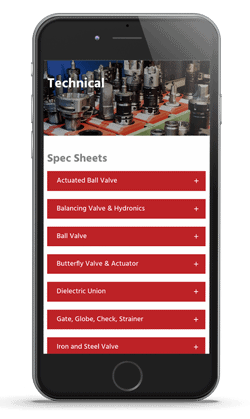Ball Valve
Comments Off on Ball ValveThe durability and versatility of ball valves make them an ideal solution for a range of industrial and commercial applications. Ball valves have a range of unique benefits. They function well even in challenging environments and can withstand exposure to high temperatures and pressures, as well as contaminated gas or liquid. RED-WHITE VALVE CORP. has been a leader in the valve industry for over 50 years. Our team of professionals can help you determine if ball valves are the best solution for your application.
What is a Ball Valve?
Ball valves are a type of shut-off valve characterized by a spherical disc that controls the flow of liquid or gas through a port. This type of valve is particularly popular in applications that feature high temperatures or pressures, as well as applications requiring a very tight shut-off. Ball valves are available with openings in multiple sizes, including standard and full port ball valves, to accommodate different flow rates. 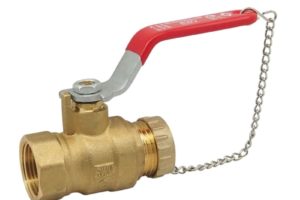
How Does a Ball Valve Work?
This type of valve may be operated either manually or by an actuator. When an external force moves the lever, the valve’s stem moves the ball by a quarter-turn, opening the valve and allowing the gas or liquid to pass through. To stop the flow of gas or liquid, the operator must turn the lever in the opposite direction. This will return the ball to its original position.
Ball Valve Features & Benefits
Several features characterize ball valves. These include:
- Valve stops
- Position indicators
- Anti-static
- Standard face-to-face dimensions
- Fire-safe
In addition, ball valves have many unique benefits, which include:
Compact Design
While some valves are quite large, ball valves have an economical design. This enables them to perform well in a versatile range of applications. Additionally, it is possible to inspect ball valves without removing them from the line.
Durability
Ball valves perform well in harsh environments. They can withstand applications in which they are exposed to high volumes, temperatures, and pressures.
Fast Shut-Off Speeds
Their responsiveness makes ball valves ideally suited for complex applications that require rapid shut-off speeds.
Corrosion Resistance
Ball valves are available in a range of materials, including stainless steel and PVC, that offer superior levels of corrosion resistance. The design of these valves also makes them less prone to damage even in challenging environments.
Versatility
As they are available in a range of materials and designs, ball valves offer high levels of versatility. They are ideally suited for an array of industrial applications.
Long Service Life
The durable, high-quality design of ball valves gives them a particularly long service life. They continue to provide strong seals even after long periods of disuse.
Ball Valve Applications
Due to the reliability and durability of ball valves, they are ideally suited for a diverse array of applications. They function well in harsh environments and continue to perform well even when they encounter contaminated media. Some of the most common applications for ball valves include:
- Compressor skids
- Turbine skids
- Generator skids
- Separator skids
- Crude oil plants
- Field gas plants
- Polymer plants
- Industrial gas processing plants
- LNG plants
- Gas feed lines
- Automated processing
- Hydrocarbon processing
- Oil refinery feedstock lines
- Tank farms
Meeting Your Valve Needs for Over 50 Years
At RED-WHITE VALVE CORP., we have spent the past 50 years working to meet the needs of our customers by manufacturing a range of industry-leading valve solutions. We are dedicated to collaborating with our customers and meeting the highest standards of customer service, with each of our representatives offering expert knowledge of our products and services. By manufacturing our products in-house, we ensure reliable and high-quality results at competitive prices. To learn more about our valve solutions, contact us or request your quote today.
Hydronic Valve
Comments Off on Hydronic ValveHydronic HVAC systems for heating and cooling operate at peak performance only after achieving hydronic balance and temperature control. The best way to ensure this is through hydronic balancing – a process of optimizing the distribution of water in a building’s HVAC system by equalizing the system pressure using hydronic balancing valves.
RED-WHITE VALVE CORP. has served the commercial, industrial, plumbing, and HVAC industries for over half a century with an extensive range of top-quality valves. Our business philosophy is rooted in integrity, quality, and reliability, allowing us to further our reputation as an industry-leading valve producer.
Balancing a Hydronic System
Hydronic HVAC systems utilize heated or cooled water to heat or cool a facility. The conditioned water circulates through a closed system to achieve the desired temperature in specific areas of the facility. For optimal performance, it is essential to implement balancing measures to prevent underflow or overflow conditions. The aim is to provide the right amount of water at the right place and at the right time. A balancing valve ensures that all zones get proper flow under design conditions, ensuring optimal efficiency, comfort, and energy savings.
Unbalanced systems can lead to insufficient or excessive heating or cooling. Unbalanced systems will also be plagued by noisy operations, high energy use, and reduced valve and pump life. 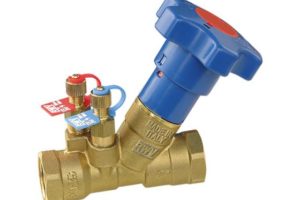
There are two types of balancing valves:
- Manual balancing (Static): Also called pressure-dependent balancing valves, static valves offer a fixed resistance to water flow. Since they don’t adjust to changing system pressure, the valve settings are calculated and adjusted before installation.
- Pressure independent balancing (Automatic): This hydronic valve throttles to produce the pressure drop required to reduce the flow rate down to the design flow rate. Unlike static balancing valves, they have internal elements which move to adjust and compensate for differential pressure changes, allowing them to maintain a constant flow and operate more efficiently under variable load conditions.
Hydronic Valve Features & Benefits
Both types of hydronic balancing valves offer unique advantages that make them suitable for different applications.
Manual Balancing Valves
Manual hydronic balancing valves are manually adjusted throttling valves that serve as a permanent resistance built into the system. They are pressure-dependent and maintain a balanced system at full-load conditions (designed load). Manual valves have several benefits:
- Sensitive – can read low rates accurately.
- Environmentally friendly – manual balancing valves use much less energy than automatic hydronic valves.
- Cost-effective – they are energy efficient, which will translate to reduced energy costs.
- Intuitive – easier to troubleshoot if there’s a problem.
Automatic Balancing Valves
These balancing valves function independently of pressure and can maintain the designed flow rate within the PSID range specified by the manufacturer. They can also maintain an overall system balance, even when other branches fluctuate. Benefits of automatic balancing valves include: 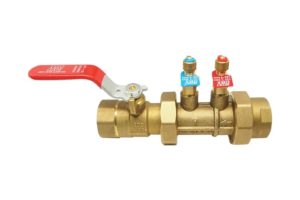
- Ease of use – unlike manual balancing valves, automatic valves can automatically adjust with changing water flow rates, so there is no need for adjustments.
- Efficient – automatic balancing valves ensure more accurate balance in the water flow distribution throughout the system.
- Durable and quiet – automatic balance valves are long-lasting and help eliminate noise and vibration in HVAC systems.
- Time-saving – automatic valves require less time and cost for maintenance.
Hydronic Valve Applications
Hydronic valves have several applications, including:
- HVAC: Hydronic balancing valves are used in HVAC systems to ensure the system delivers proper flow to all terminals.
- Heat exchangers: Balancing valves are used in heat exchangers to deliver the desired flows in low temperature, chilled, or hot water applications and provide the desired flow rate to maintain comfort and energy.
- Power generation systems: Hydronic flow control valves are used in power generation systems to control conditions such as flow, pressure, temperature, and liquid.
- Refrigeration systems: Hydronic valves control the flow of liquid refrigerant between the low side and high side of a refrigeration system.
- Server cooling systems: Hydronic zone valves are used to regulate water flow in hydronic server cooling systems.
- Water return lines: Hydronic check valve keeps water flowing in one direction only and prevents reverse flow.
Hydronic Balancing Valves from RED-WHITE VALVE CORP.
At RED-WHITE VALVE CORP., we manufacture and distribute a broad selection of balancing valves. Our valves feature brass (DZR) construction for superior corrosion resistance and a fixed venturi design for easier setting requirements. We also offer accessories for all types of connections. Contact us today to request a quote.
Use of Balancing Valves in Hydronic Systems
Comments Off on Use of Balancing Valves in Hydronic Systems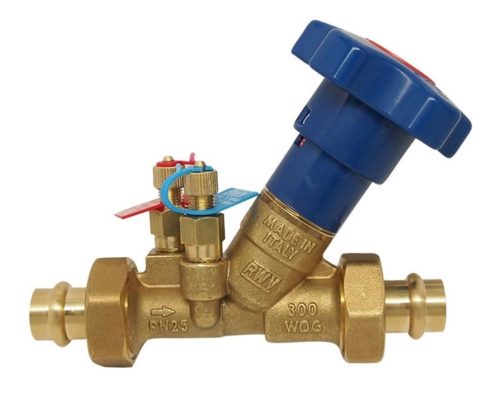 Balancing valves are throttling devices designed to regulate the fluid flow through hydronic components. In hydronic systems (HVAC systems that use water as a medium to heat and cool areas of the facility), they facilitate the distribution of heated or chilled water to all terminals. As a result, the system is able to achieve optimal performance, which translates to higher operating efficiency and lower operating costs.
Balancing valves are throttling devices designed to regulate the fluid flow through hydronic components. In hydronic systems (HVAC systems that use water as a medium to heat and cool areas of the facility), they facilitate the distribution of heated or chilled water to all terminals. As a result, the system is able to achieve optimal performance, which translates to higher operating efficiency and lower operating costs.
The following article discusses balancing valves for chilled water systems and heated water systems, including what they do, how to adjust them, and typical applications.
What Does a Balancing Valve Do in HVAC Systems?
The flow of fluid in an HVAC system is constantly changing to accommodate alterations in the conditions of the facility. Some of the factors that influence the demand for heating and cooling include building occupancy levels and heat from the sun. Properly designed and constructed HVAC systems should be able to offer the correct output when and where it is required. In unbalanced systems, there is a risk of underflow or overflow conditions, which can lead to insufficient or excessive heating or cooling. Balancing valves ensure the system delivers the right flow to all of the terminals, given the current facility conditions.
How a Balancing Valve Works
Hydronic Circuits
The flow of fluid in an HVAC system is constantly changing to accommodate alterations in the conditions of the facility. Properly designed and constructed HVAC systems should be able to offer the correct output when and where it is required.
Unbalanced System
Water will take the path of least resistance. Unbalanced systems risk underflow or overflow conditions, which can lead to insufficient or excessive heating or cooling. Rooms further from the pump receive less water due to different “resistances” created by lines of different length. Head loss grows with pipe length, turns, restrictions and gravity.
Balanced System
Balancing valves add the proper “resistance” on all lines, ensuring that the system delivers the right flow and temperature to all of the terminals, given the current facility conditions.
How Do You Adjust a Manual Balancing Valve to Maintain System Balance?
Differential pressure manometers/balancing computers—measure the pressure difference between two pressure points. Industry professionals can use this tool to calculate flow rates and determine if and when adjustments on the balancing valve(s) are needed to maintain system balance.
Typically, an HVAC system has a balancing valve for each terminal-unit coil and air-handling unit (AHU). Adjusting all of them to maintain system balance involves several steps. For manual balancing valves, these are:
- Connecting a differential-pressure gauge or circuit-balancing instrument to the two metering/test ports of the valve
- Determining the required rate of flow through the balancing valve
- Adjusting the handwheel to achieve the proper flow rate
- Repeating the above steps for all balancing valves
Applications of Balancing Valves
As indicated above, balancing valves help achieve and maintain proper conditions within hydronic systems. In addition to being used in HVAC systems, they are also integrated into the following:
- Heat exchangers
- Power generation systems
- Refrigeration systems
- Server cooling systems
- Water return lines
Contact the Valve Experts at RWV Today
Balancing valves are an essential component of hydronic systems. They ensure the proper temperatures within the facility are achieved and maintained, energy utilization is optimized, and operating costs are reduced. If you need balancing valves for your facility, turn to the experts at RWV.
At RED-WHITE VALVE CORP., we manufacture and distribute a broad selection of balancing valves. Our valves feature brass (DZR) construction for superior corrosion resistance and a fixed venturi design for easier setting requirements. We also offer accessories for all types of connections. To learn more about our products and how they can benefit your hydronic system, contact us today.

